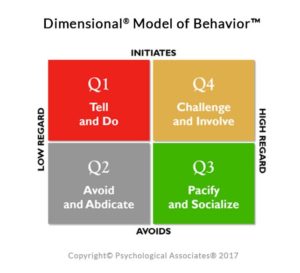
Set Up For Success – How to Help Your Employees Engage, Thrive & Stay
Does Money Motivate Employees
Have you ever seen the Peter Principle in action–people rising to their level of incompetence? This can be quite costly for companies. It is not healthy to make promotion decisions that don’t work out or to lose good people. The question in the case example is: How can you prevent the Peter Principal from happening in your organization? Does money motivate employees? Is the solution giving healthier raises? Or is there something else involved in promoting your people to set up for success? After reading this case and exploring the 3 alternatives, you’ll know your best approach in helping ward off the Peter Principal.
The Situation
You are vice president at a company that uses a lot of customer support personnel. Two years ago, you hired Kim to help train new recruits who would become customer service reps in a new division of your company.
Hire and Develop the Best
Kim turned out to be an excellent hire. She related well with these trainees, even better than the professional training consultant. Now, the training program is over, and you want to keep Kim as an employee.
To reward her, you offer her a higher position with a 10 percent raise, a large office and other perks. In her new job, she’ll help develop web-based training materials for another branch of the company.
Disappointing Results
She seemed pleased by the move up, but in the months since, Kim’s performance has been lackluster. Her work is satisfactory, but she’s not turning in the stellar performance she used to. You heard a rumor she may leave the company.
Employee Motivators
You wanted her to succeed. As a Q4 leader, what could you have done differently to help ensure that Kim would remain an all-star contributor to the company?
Your Choices:
No, please try again.
A 10% Raise Was Too Little. Make it 20%
Obviously, if you could go around doubling employees’ salaries to keep them happy, that might boost motivation. But no manager has that option. If you had bumped her salary by, say, 20 percent, would that have changed things?Kim’s modest raise is probably not what has dampened her enthusiasm. Research shows that a bigger salary is not what motivates employees day-to-day to perform at a high level. All else being equal, you have to ask if Kim’s new job is meeting her intangible needs. More than raises and perks, intangible benefits are often what galvanize people to come to work with enthusiasm and purpose. For Kim, Throwing more money at the problem–Answer A–won’t set up for success. See Answer B.
Figure Out What Motivates Kim. Try to Provide That in Her Job
Kim’s old job was going away, but you wanted to retain a high-value employee. Sizing up what motivated Kim to perform so well would probably have shown that she likes working with people. Therefore, her intangible needs of Q3 (social, belonging) and Q4 (helpful, influencing) were satisfied greatly in her training role.It’s true that your company can’t afford to invent a job that will motivate Kim just because she’s a proven employee. However, Kim went from always working with people to doing so only about 10 percent of the time, a shift that ignores her intangible needs and benefits.
As a motivating, Q4 leader, you might have 1) found Kim another essential job with high interaction (sales, leading focus groups in marketing, management) or 2) combined several vital roles that would have provided greater interaction with people. This might entail some retraining. If you feel that’s too much bending over by your company, keep in mind that developing a proven, superior talent from within your company — in the right role — has a much higher chance of high performance than hiring from the outside. Answer B is the best way to set up for success.
Time to Part Ways?
It’s almost always better business to develop a proven employee for a new position than to go outside. If properly motivated by her job, Kim will apply the dedication she had before. Answer B highlights how to match an employee’s personal needs to the work your company has to accomplish. Answer C is not the optimal strategy.No, please try again.
Setting You Up for Success
Now that you know how to set up for success when it comes to your promoted employees, let’s talk about setting you up for further success.
If you’d like more leadership knowledge, the Learning for Leaders area of our website offers a bevy of resources. We have 40 more leadership case examples, white papers, a Do You Work with a Difficult Person questionnaire that provides actionable suggestions on dealing with your situation,…
If instead of learning more about leadership, you want to put your leadership skills into action, check out our leadership development page. We offer a variety of tools to help you become the most effective Q4 leader you can be: leadership workshops, executive coaching, 360 feedback, and more.
Don’t forget to subscribe to our newsletter. It will also help set you up for success by listing upcoming events and new leadership information.










